Irish Dance: Evolution from Traditional Jigs to Modern Choreography
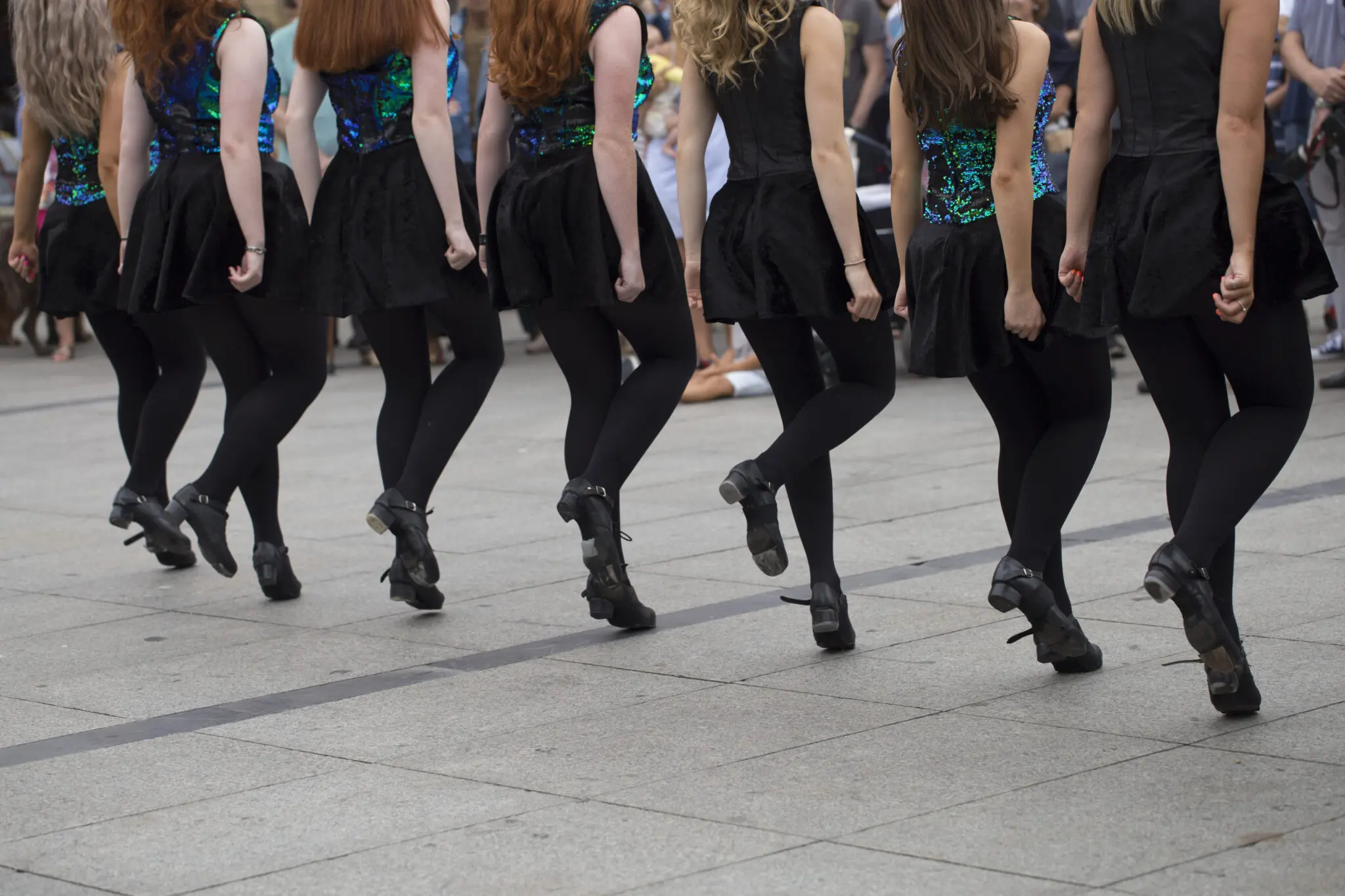
Updated On: April 21, 2024 by Raghda Elsabbagh
Irish dance, a vibrant facet of Ireland’s cultural heritage, has captivated audiences worldwide with its dynamic footwork and spirited rhythm. Historically woven into the social and celebratory fabric of Irish life, this distinctive dance form springs from a rich tapestry of folklore and tradition. As we trace its evolution, we see a journey from humble community gatherings and céilís to grandiose stages across the globe, where the traditional jigs and intricate reels continue to resonate with the timeless spirit of Ireland.
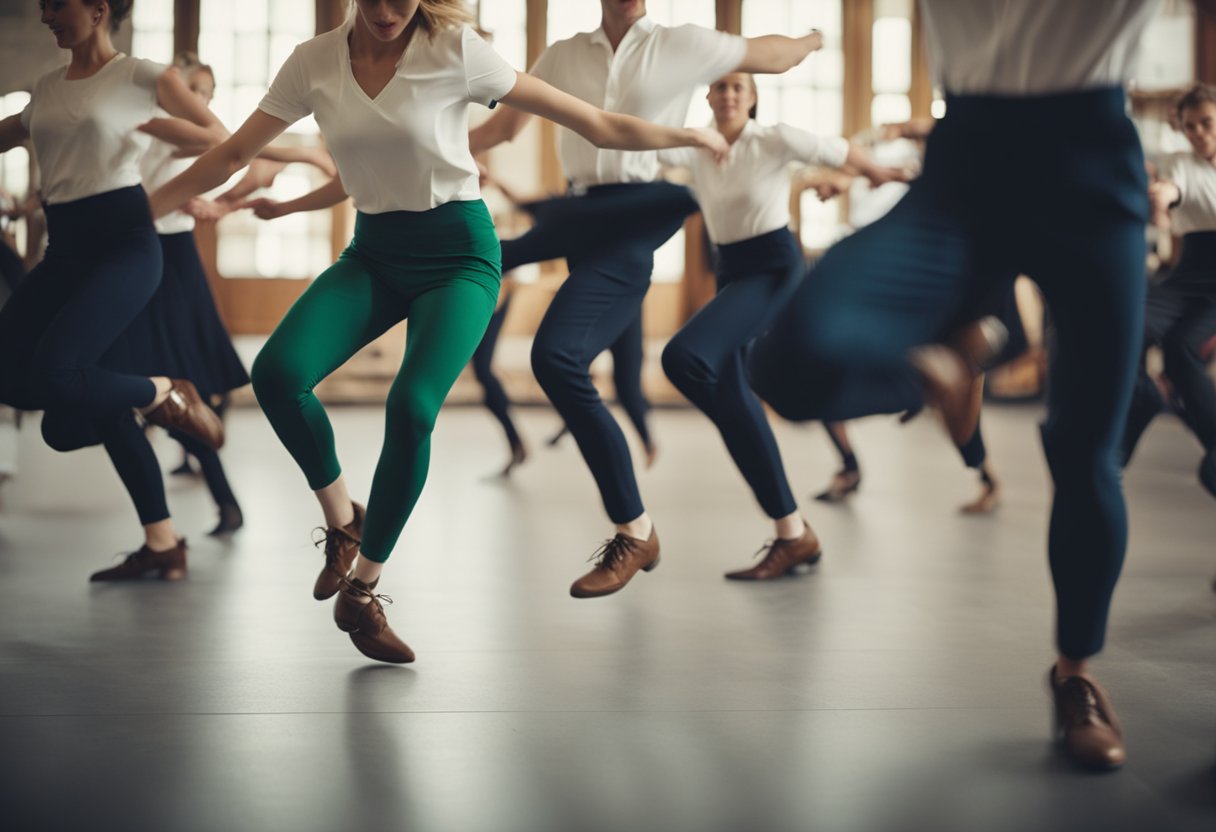
Throughout its journey, Irish dance has embraced myriad styles and techniques that showcase both the dancers’ skill and the expressive potential of the genre. From the iconic stiff upper body to the rapid-fire precision of their steps, dancers both adhere to and innovate within the traditional framework. The evolution of its attire, music, and competitive scene further exemplifies the art form’s fluidity and resilience. It’s not only a fascinating artistic expression but also a vehicle for cultural storytelling, uniting the Irish diaspora and spreading the story of Ireland’s rich cultural landscape around the world.
Table of Contents
The Historical Roots of Irish Dance
Irish dance, an integral aspect of our heritage, has evolved over centuries, shaped by various cultural influences and historical events. It is a reflection of Ireland’s vibrant history and a testament to its enduring spirit.
Early Origins and Influences
Irish dance has deep roots in Ireland’s Gaelic culture, where dance was an important part of life, connecting us to our Celtic ancestors. Historical records are sparse, but we know that the Gaels brought their own forms of dance to Ireland, infusing it with their unique traditions. There’s evidence to suggest that these early dances were influenced by the Druids and the Celtic festival celebrations. The exchange of culture wasn’t one-sided; Scotland also played a role in shaping the traditions, with similarities seen between Irish and Scottish dances.
While English and French dances primarily influenced the courtly and aristocratic circles, the traditional Gaelic forms remained popular among the general population. Step dances, which are the heart of Irish dance, emphasise intricate footwork while keeping the upper body largely immobile, a style likely developed to adapt to tight spaces inside peasant cottages.
Royal Patronage
The course of Irish dance history changed with royal endorsement. Queen Elizabeth I herself was said to be quite fond of the Irish jig, a lively dance form that had been part of Irish culture for centuries. The patronage by royalty, particularly during the English reign, brought visibility to Irish dance, ushering it into the royal courts and elevating its status.
The 17th and 18th centuries saw travelling dance masters spreading their knowledge across Ireland, contributing to the development and formalisation of Irish dance. These masters not only taught dance but often created new steps, adding to the rich tapestry of Irish culture.
While Irish dance faced periods of decline during historical hardships, it saw a substantial revival with the formation of the Irish Dancing Commission in the 20th century, which standardised teaching and competitions, ensuring the preservation and continuation of this vital part of our heritage.
Irish dance, through its history, has become a symbolic representation of the Irish spirit: adaptive, vibrant, and resilient, transcending beyond the shores of its homeland to captivate hearts globally.
Styles and Techniques of Irish Dance
In this exploration of Irish dance, we turn our focus to the diverse styles and techniques that have developed over centuries. From traditional forms to the intricacies of modern execution, these elements form the heartbeat of Irish dance culture.
Jigs, Reels, and Hornpipes
Irish dance music typically encompasses a trio of rhythmic tunes: jigs, reels, and hornpipes. The jig, danced in 6/8 time, can be further classified into light jigs, slip jigs, and single jigs. Light jigs are the most rapid, providing a lively tempo suitable for beginners, while slip jigs, known for their graceful movements, are danced in 9/8 time and are traditionally performed by women.
Single jigs, or hop jigs, offer a slightly varied rhythm and cadence. Reels—4/4 tunes with a quick-paced, lively beat—are equally fundamental in Irish dance, compelling dancers to maintain a swift, bouncing rhythm. Hornpipes, executed in either hard or soft shoes, are known for their pronounced accents and slower tempo, allowing for more deliberate and staccato movements.
Step Dancing Fundamentals
At the core of Irish dance lies step dancing, a genre characterised by rapid and precise footwork. Dancers utilise both soft shoes (ghillies) and hard shoes, each serving different styles and sounds. Ghillies are lace-up leather shoes used primarily in dances like light jigs, slip jigs, and reels, intended to emphasise the intricate footwork without the percussive elements. Conversely, hard shoes introduce a percussive dynamic that enriches the performance of set dances, hornpipes, and treble jigs. It’s the complexity and precision of the footwork that often define a dancer’s skill level.
Solo versus Ceili Dancing
Irish dance is enjoyed both individually and in groups, with unique characteristics defining solo and ceili (pronounced ‘kay-lee’) dancing. Solo dancing focuses on the individual’s technique, showcasing their skill in set dances and the execution of intricate footwork with a strong emphasis on performance and competition. In contrast, ceili dancing is a collective experience. Comprising dances for groups of two to sixteen or more people, ceili dances involve patterns and sequences that weave dancers together, combining social interaction with cultural tradition. Whether thriving in the competitive scene or revelling in the social environment, Irish dance offers a rich array of experiences for novices and experts alike.
Irish Dance Attire
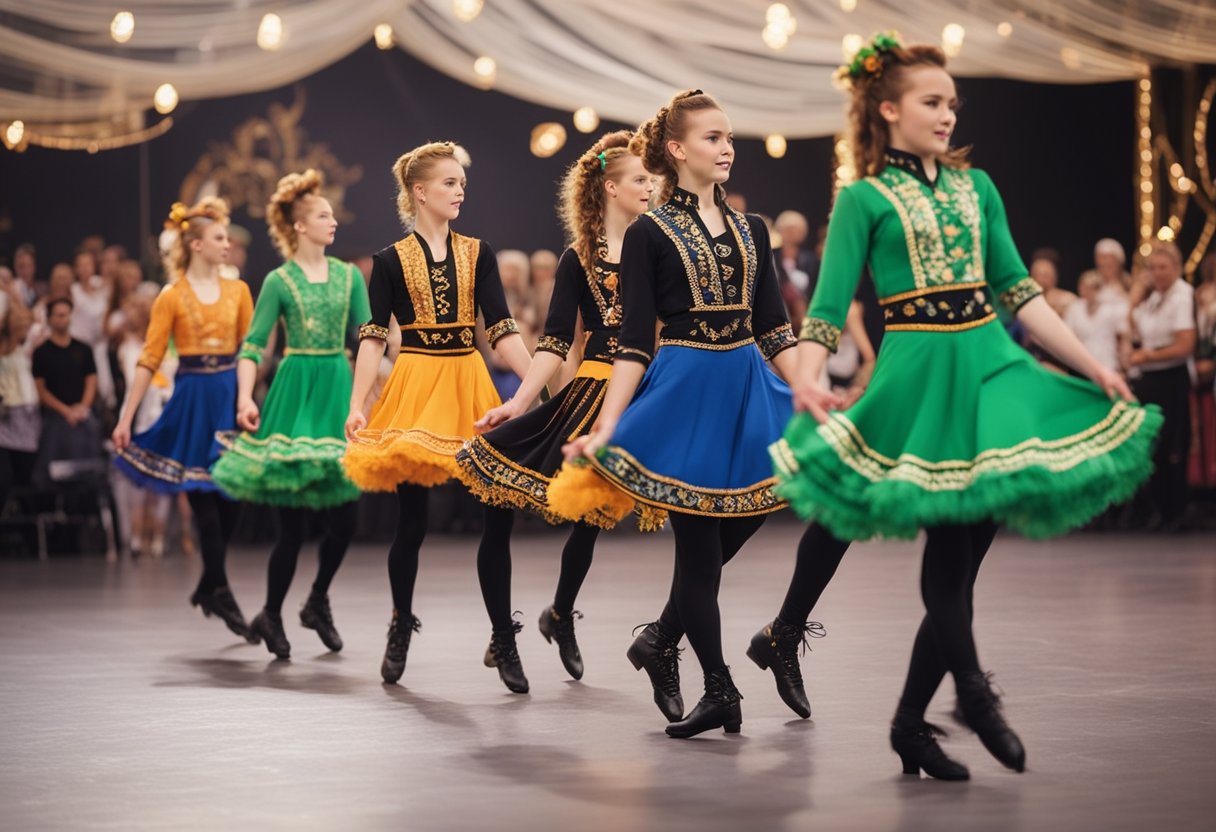
In Irish dance, the attire worn by dancers is a significant aspect that has evolved over time, reflecting both tradition and modern influences.
Traditional Costumes
Men’s Attire:
- Shirts and Kilts: Traditional attire for male Irish dancers typically includes a shirt paired with a kilt, often in a tartan associated with a particular Irish county.
- Long Coats and Briques: Some dancers may opt for a long coat and briques, which are calf-length trousers, as well as a vest that adds a formal touch.
Women’s Attire:
- Blouses and Skirts: Female dancers traditionally wear blouses with long skirts. The skirt’s length and fabric often reflect the style of the dance being performed.
- Lace and Embellishments: The addition of laces and intricately embroidered designs is common, adding elegance to the costumes.
Modern Outfits
Female Costumes:
- Vibrant Dresses: Modern female dancers often wear short, vibrant dresses with extensive embroidery and rhinestones. These dresses are tailored to stand out during performances.
- Covered Arms: Regardless of the dress cut, arms are almost always covered, whether by the dress itself or by coordinating leggings or sleeves.
Male Costumes:
- Trousers and Vests: Today’s male Irish dancers might wear trousers connected with a vest adorned with Celtic designs.
- Modern Styling: While being rooted in tradition, modern male outfits have evolved to incorporate contemporary fashion elements for stage appeal.
Outfits worn in Irish dance are not just costumes but hold historical significance and play a role in the visual appeal of the dance. Traditional Celtic dance costumes have deep roots, while modern attire reflects the dynamic nature of this cultural art form.
Music and Instruments
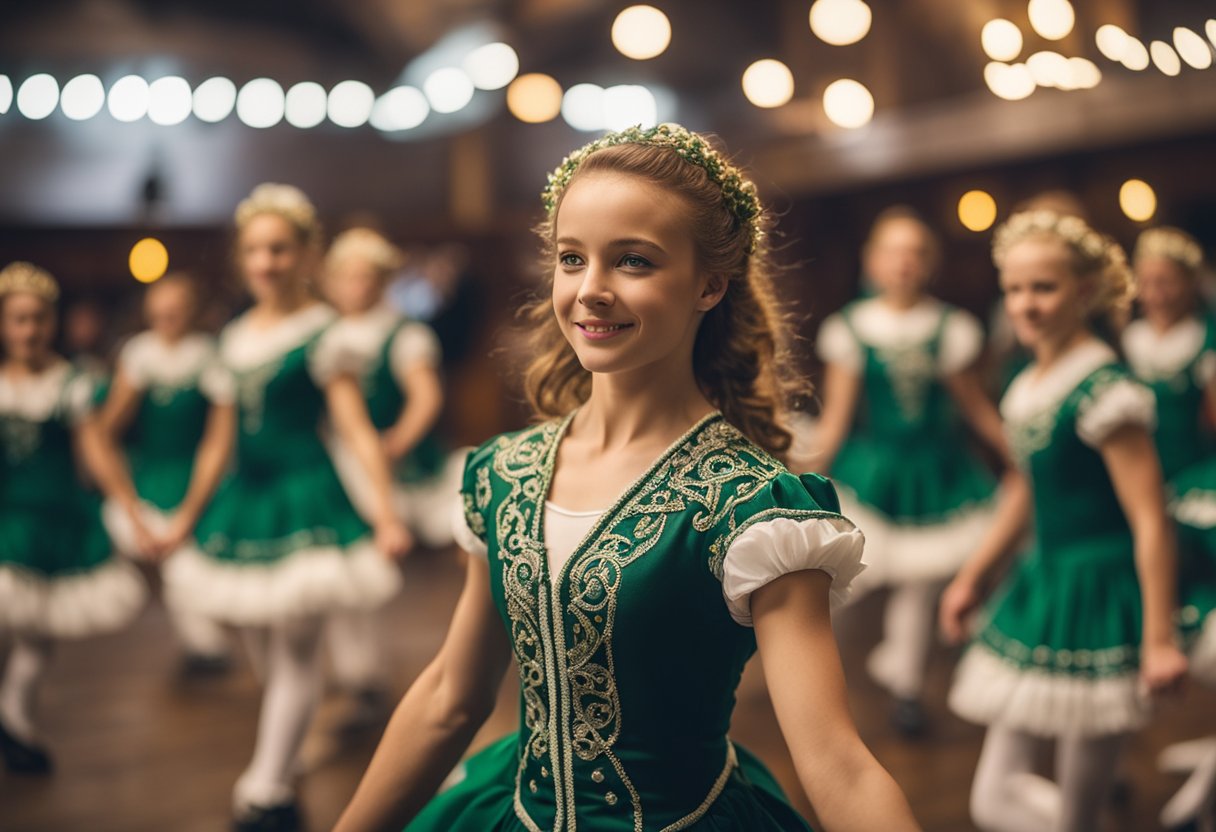
In Irish dance, music breathes life into the movements, and the instruments are the heart that pumps rhythm and melody through the dance.
Traditional Irish Music
Traditional Irish music is the backbone of Celtic dance, with the Irish jig being one of the most celebrated dance forms. The jig is known for its lively tempo and intricate footwork, encapsulating the essence of Irish culture.
- Reels: Fast-paced and joyous, often accompanying more athletic dance steps.
- Jigs: Characterised by a vibrant, bouncing rhythm that energises dancers and audiences alike.
These traditional pieces are not mere tunes; they are stories told through music, each with its own rhythm and spirit that inspires the dynamic steps of Irish dance.
Instruments for the Dance
The sound of Irish dance is inseparable from the instruments that create it. Here’s a brief overview of the traditional instruments that define the genre:
- Fiddle: Offers a rich range of tones, from soft, melodic lines to rapid, high-energy staccatos.
- Harp: With its celestial sound, it adds depth and a touch of elegance to the music.
- Tin Whistle: Contributes a high-pitched, clear melody that cuts through the dance hall with its distinctive sound.
- Bagpipes (Uilleann pipes): Provide a haunting drone that complements the rhythmic elements of the dance.
- Concertina: A reed instrument whose vibrant bellows-driven notes add a unique texture to the mix.
- Banjo: Brings a buoyant, plucky character to the arrangement.
- Pipes: Similar to the bagpipes, adding a resonant, reedy timbre to the ensemble.
Each of these instruments plays a pivotal role in the orchestration of a dance, blending together to create a soundscape that propels the dancers’ feet and uplifts the spirits of the audience.
Understanding Irish Dance Competitions
In the competitive world of Irish dance, dancers showcase their skills in high-energy events known as feiseanna, seeking recognition and rankings from certified judges.
Feiseanna and the Competitive Realm
Feiseanna, the plural of ‘feis’, are festivals that centre around Irish dance competitions. These events are integral to our cultural traditions, often including other aspects of Irish heritage such as music and language. In the domain of set dancing and Irish step dancing, competitors ranging from young children to adults partake in various levels of feiseanna. Each feis follows a structure that caters to different skills, from the traditional rince of soft shoe dances to the more modern and complex modern Irish dance numbers that push the bounds of the traditional form, introducing new rhythms and choreography.
Judging the Performance
Judges at these contests are tasked with the difficult job of evaluating performances. They assess a range of aspects, from technical execution to overall artistry, awarding points based on precise criteria. The scoring process remains consistent across the board to ensure fairness. In Irish step dancing, for example, judges pay close attention to footwork and timing, as well as the dancer’s posture, presentation, and synchronization with the music. The adjudicators’ extensive training and experience are vital in these competitions, ensuring that every detail, no matter how minute, is given due consideration when tallying the final scores.
The Evolution of Irish Dance
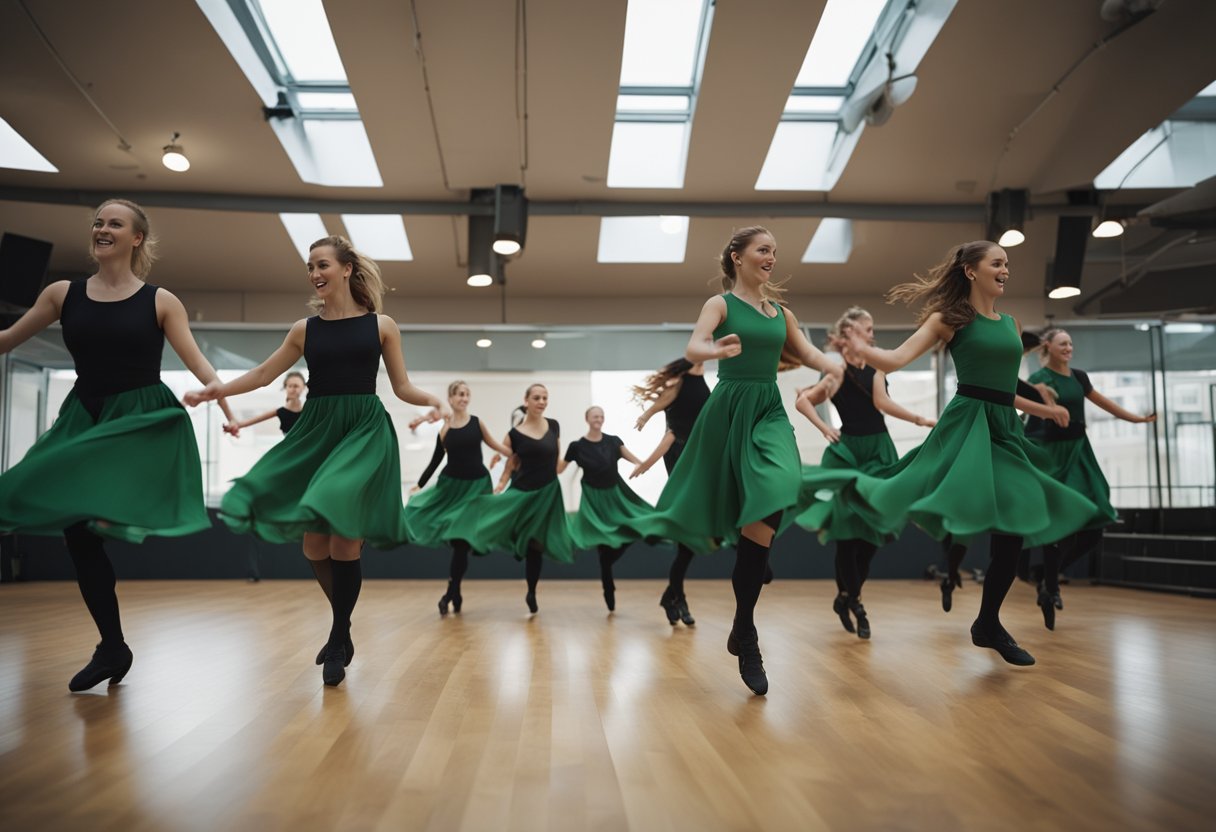
Irish dance has undergone a remarkable journey, transforming from traditional folk dances into a vibrant, internationally recognised performance art. Let us explore the critical stages of this evolution and how it continues to captivate audiences worldwide.
Revival and International Appeal
The revival of Irish dance can largely be attributed to the global success of shows like Riverdance. Premiering in Dublin in 1994 and quickly moving to stages in New York and beyond, Riverdance showcased Irish step dance with a contemporary twist, leading to a surge in popularity. This modern take on traditional forms sparked a renewed interest in Irish culture, with dance schools proliferating across Canada, the United States, and other countries. This transformation signified not just a revival of an art form but the birth of modern Irish dance as we know it.
Crossover into Mainstream
Irish dance crossed into mainstream entertainment on the back of its newfound revival. The electrifying blend of swift leg movements and rhythmic precision caught the public’s imagination, leading to a global community united by an appreciation for this unique dance style. The melding of traditional jigs with modern steps has given rise to a genre that maintains its cultural roots while evolving to resonate with diverse audiences. Shows centred on Irish dance have toured worldwide, enabling a broader cultural exchange and dialogue, thereby cementing Irish dance’s place in mainstream performance art.
Irish Dancing for Men and Women
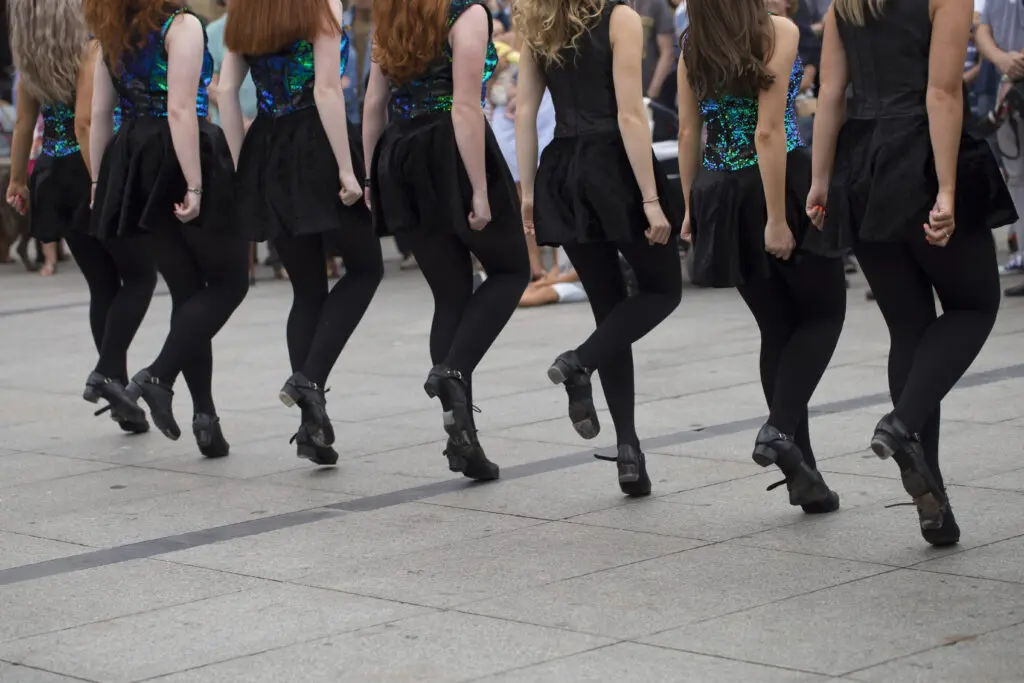
Traditionally, Irish dancing has been a social activity for both men and women, rich in culture and rooted in Celtic history. It has evolved into a competitive performance art where both genders participate with enthusiasm and skill.
Genders on the Dance Floor
In traditional folk dance settings, gender roles within Irish dancing were quite defined, with men and women performing dances that were appropriate for their gender. Yet, as the dancing tradition has modernised, these roles have become more fluid. Both men and women now often perform the same dances during competitions and performances, showing the progression in both skill and acceptance within the community.
Men have traditionally been known for their strength and athleticism in dances like the jig, while women were praised for their grace and precision. Even in modern performances, these attributes are enhanced by the choreography, which allows both men and women to exhibit their skills equally.
Costume Variations by Gender
Costume within Irish dance is a distinct part of the tradition, with gender playing a role in the design and style of the garments.
Men typically wear:
- Trousers or a kilt for a nod to Celtic heritage
- A jacket or vest
- A shirt, which might be plain or elaborately decorated
Women typically wear:
- Dresses with skirts, often adorned with Celtic designs
- Shawls or capes that add to the traditional look
- Soft shoes, known as ghillies or hard shoes, emphasise the rhythm of the dance
Costumes for both genders are often designed to stand out during competitions, with vibrant colours and intricate embroidery reflecting the rich tapestry of Irish culture, merging history with modern aesthetics.
Cultural Significance and Folklore
In exploring the tapestry of Irish culture, one cannot overlook the integral role played by Irish dance. A symbol of identity and a repository of myths and symbolism, it mirrors the cultural heartbeat of the Gaelic people.
Dance and Irish Identity
Irish dance is a poignant assertion of Irish heritage. Rooted in the social gatherings of the Celts, it has flourished through centuries, shaping and reflecting the values and spirit of the nation. Irish folk dances like Ceili promote unity, evoking the times when communities bonded over animated reels and jigs. This dance form has not only persisted but also evolved, symbolising resilience and adaptability—a core element of our identity. We’ve witnessed this vibrant aspect of our culture enchanting audiences worldwide as it transcends language and resonates universally.
- Traditional Events: At gatherings, the performance of quadrilles and long dances were occasions for showcasing community and individual prowess.
- Modern Evolution: Irish dancing steps, once severe and composed, now incorporate more lively movements, illustrating how our traditions adapt while maintaining their essence.
Myths and Symbolism
Each nuance of Irish dance brims with layers of symbolism and lore. The intricate footwork and costumes stem from deep connections with folklore, conjuring images of mystical Celts whose storytelling was as much in their movements as their words. In Irish dance, we find an avenue where ancient meets modern, and myths find new life.
- Mythology and Storytelling: Movements often narrate tales of Irish legends, where dancers might echo the feats of warriors or immortalise the deeds of historical figures.
- Expressing Heritage: The tight choreography and rhythmic precision illustrate themes of discipline and community, alluding to historical social structures and the Gaelic love for harmonious expression.
In understanding the profound cultural significance of Irish dancing and the folklore it enshrines, we grasp a clearer picture of the past and its echoes in the present.
Teaching and Learning Irish Dance
In the pursuit of mastering Irish dance, both the transmission of historical technique and the innovation in choreography play pivotal roles.
Role of the Dancing Master
The dancing master is central to the preservation and teaching of Irish dance. In times past, these itinerant teachers would travel from village to village, imparting their knowledge of dance steps and the culture inherent within them. Today, dancing masters continue this tradition in dance schools across the globe, using both traditional techniques such as the rinnce fada and modern methods to train new generations of dancers. They are responsible for teaching complex movements, from simple shuffles to the more intricate dance steps.
Sharing Knowledge and Skills
Irish dance has a rich heritage that is shared through both formal instruction and community involvement. Dance masters often host workshops and ceili where knowledge and skills are passed on in a communal setting, reinforcing the social aspect of the culture. Dancers learn perfect styles, from graceful soft-shoe dances like the slip jig, which are noted for their elegance, to energetic hard-shoe dances.
Resources like The Ultimate Beginner Guide To Irish Dance – Irish Dancing World provide accessible information for learners at different stages, reinforcing the shared learning environment. Through such exchanges, the vibrant tradition of Irish dance thrives, continually evolving while staying rooted in its rich history.
Irish Dance Around the World
Irish dance, with its energetic jigs and precise footwork, transcends its traditional roots and now captivates audiences globally. We’ve seen the rince prosper far beyond its Irish homeland, echoing through the dance halls and stages across continents.
In Scotland, Irish dance shares a kinship with Scottish dancing traditions, with both drawing from their Celtic connections. Dancing masters once travelled between Scotland and Ireland, helping to exchange techniques and styles. The long dance traditions of both cultures continue to be celebrated and intertwined.
Heading across the Atlantic, we find Irish dance has placed an indelible mark on cities like New York. Here, Irish immigrants integrated their rich cultural heritage, including dance, into the melting pot of American society. As a result, many Irish dance schools and communities thrived.
Canada, too, embraces Irish dance, with multiple festivals and competitions showcasing its evolution with a modern flair. It’s a testament to international appeal, as Canadian dancers often perform both traditional numbers and contemporary choreographies influenced by Irish techniques.
The spread of Irish dance around the world signifies how dance as an art form can cross borders and generations. Our shared appreciation for the rhythm and skill of this cultural gem further strengthens the bonds between nations and showcases the lasting impact of Irish culture on the international stage.
| Country | Influence of Irish Dance |
|---|---|
| Scotland | Irish dance schools, integration into the cultural fabric |
| New York | International competitions festivals celebrating Irish dance |
| Canada | International competitions and festivals celebrating Irish dance |
We find ourselves in awe of how Irish dance continues to weave its components of history, movement, and music into the cultural tapestry of places far and wide.
Frequently Asked Questions
In this section, we’ll address some common inquiries about the rich tradition and modern practice of Irish dancing, shedding light on its history, attire, and stylistic evolution.
What are the distinct styles of Irish dancing?
Irish dancing encompasses several styles, including the well-known solo Irish step dancing, characterised by rapid leg and foot movements while the upper body remains largely stationary. Group dances include céilí dancing, which involves several couples dancing together in formation, and set dancing, akin to square dancing. Sean-nós, an old free-form style, features a looser, more relaxed form and is danced solo.
Can you explain the historical ban on Irish dancing?
Historically, Irish dancing faced restrictions under British rule when gatherings were discouraged, and cultural expressions, including dance, were suppressed. To circumvent these restraints, people danced behind half-closed doors or windows, ensuring that movements were not visible from outside, leading to the stationary upper body characteristic of today’s Irish step dancing.
Could you describe the evolution of Irish dance attire?
The attire for Irish dancing has evolved significantly. Initially, dancers wore everyday clothing, later evolving to more ornate versions for performances. Today’s dancers often wear dresses with intricate Celtic designs and stiff, full skirts for females, with males sporting a tailored jacket and trousers. The aforementioned Rise Academy of Dance website also outlines differences in attire between beginner and advanced dancers.
What distinguishes traditional from modern Irish step dancing?
Traditional Irish step dancing focuses on precise, technical movements with minimal upper body movement and is performed in traditional Irish music. In contrast, modern influences have introduced new elements, such as theatricality, contemporary music, and looser styles, as seen in popular shows like Riverdance and Lord of the Dance.
Why is the arm position in Irish dancing typically stationary?
The arm position in Irish dancing is a distinctive trait, where dancers hold their arms firmly at their sides. This tradition hails from an emphasis on intricate footwork and leg movements, as well as historical anecdotes that dancing was performed discreetly to hide beneath window levels during times of cultural suppression.
How has Irish dancing developed over the years?
Irish dancing has progressed from a primarily social pastime to a competitive and performance art. It has been carried globally, adapting and incorporating elements from other dance forms. The focus on technique, choreography, and athleticism has intensified, with competitions and public performances becoming vital components in celebrating and sustaining the art form.






